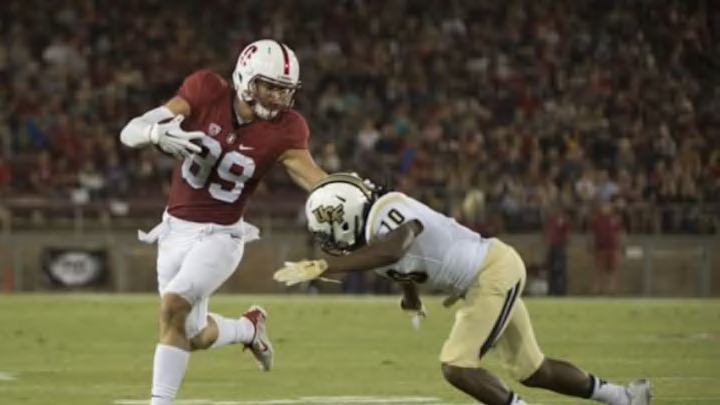2016 NFL Draft: Devon Cajuste, a wide receiver from Stanford, is one of the more intriguing prospects in this class and someone who might wind up as a better pro than college player…
Devon Cajuste is not going to put himself in the same conversation as LaQuan Treadwell, Corey Coleman, or the other top receivers in this draft class. Heck, he might not even hear his name called if he doesn’t show out at the 2016 scouting combine or Stanford pro day…
Where Cajuste is set to make his mark is as an NFL player, and I’m here to tell you why.
The sample size is somewhat small, but Cajuste is the whole package as a developmental receiver prospect and someone who could wind up being a really intriguing pickup come late April…
At A Glance
Name: Devon Cajuste
Ht: 6’4″
Wt: 230 pounds
Class: Senior
Hometown: Seaford, NY
Notable 2015 statistics
27 receptions, 383 yards, 3 touchdowns
Prospect Video
Translatable traits
1. Size
Cajuste came to Stanford as a tight end prospect, and leaves as a wide receiver. That ‘tweener’ status could hurt him or actually really help him, but it might not be getting him drafted any higher. He’s fast enough to play wide receiver, but probably not big enough to be a tight end. I think no matter what way you spin it, Cajuste is going to be able to catch a lot of passes at the next level because he’s so much bigger than defensive backs and faster than linebackers.
When you watch him torch Notre Dame, he is exploiting a decimated secondary but he’s also proving his value at the next level. He isn’t going to be easily stopped whether playing inside or out.
2. Versatility
In addition to playing outside as a receiver, Cajuste can play inside as a slot, and you could also try and use him as a TE/H-back at the next level. Like I mentioned before, he’s not big enough to play in-line tight end, but he’s still a good blocker and does a great job of seeking out defenders to create openings in the running game.
That was one thing I really liked when watching Cajuste — when he wasn’t catching passes, he was always finding someone to block, some way to contribute to a positive play.
3. Hands
Of course, you can’t play receiver if you don’t have hands. I reckon if Stanford had a more traditional passing QB — even though Kevin Hogan was pretty good this year — Cajuste might have put up some big numbers. He showed off strong hands and an ability to win matchups because of his ability to high point the ball and catch it far away from his body.
Bottom Line
Because of his size, hands, and deceptively good straight line speed, I like Cajuste as a late-round player who has some serious upside. If he tests well at the Combine, he could be a guy that goes maybe in the 5th or 6th round. Otherwise, his size and hands as well as the ability to block will get him noticed by NFL teams, and he’ll latch on quickly at camp.
I could see him being a better professional player than he was a collegiate one.
